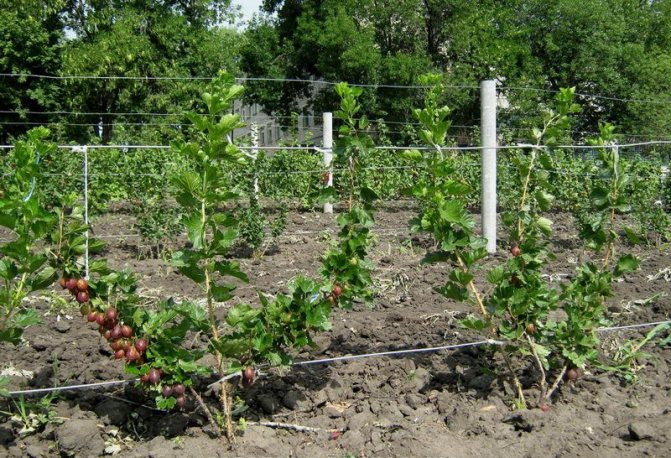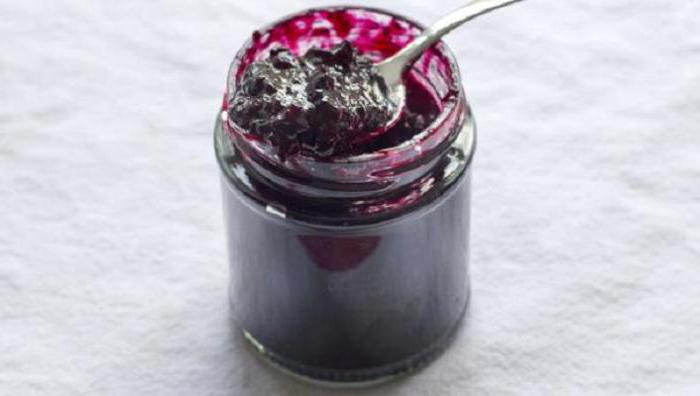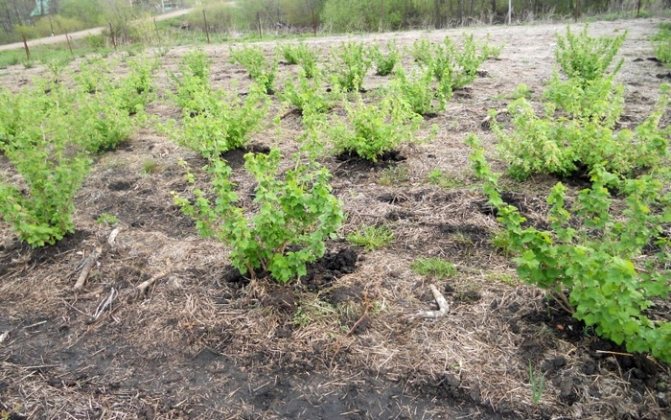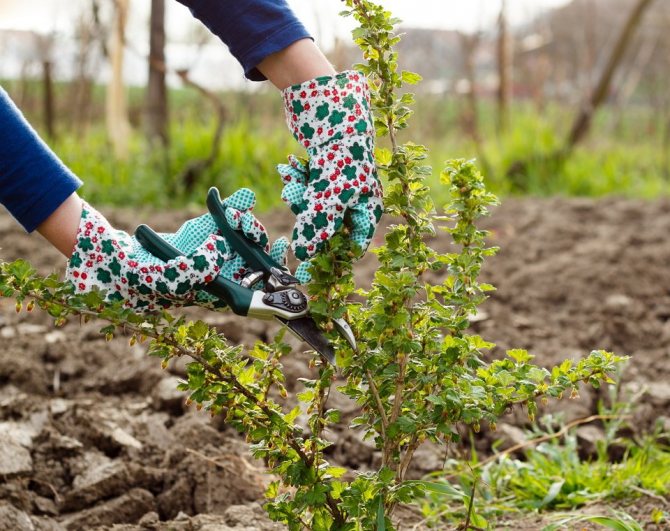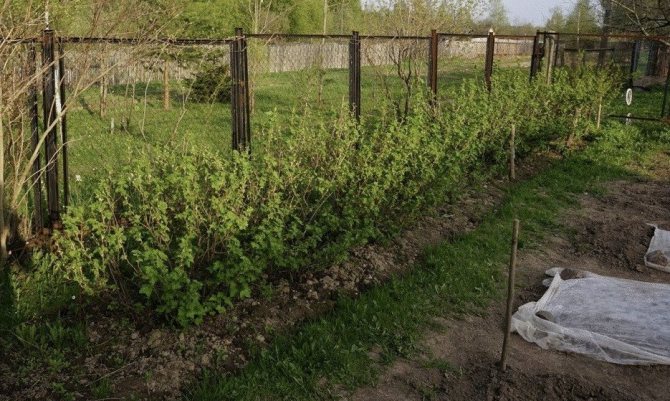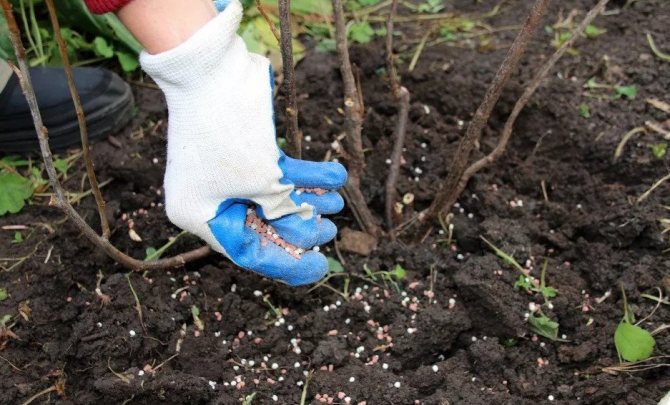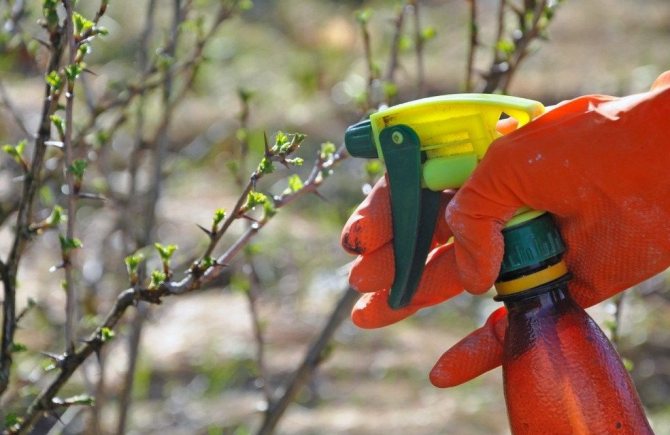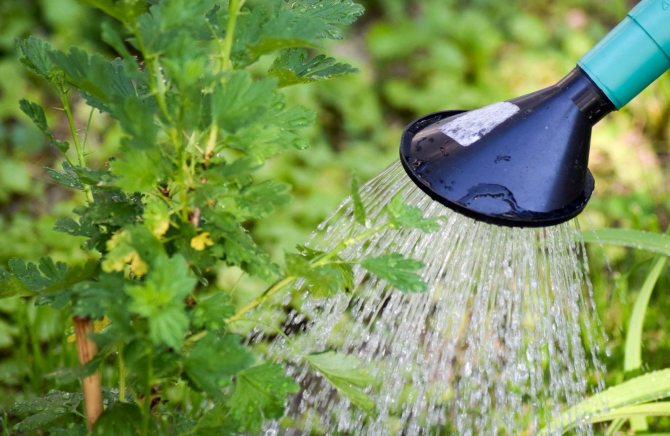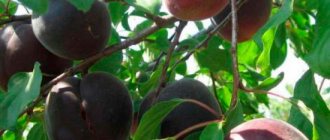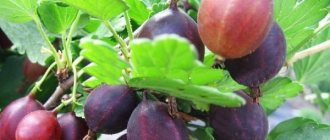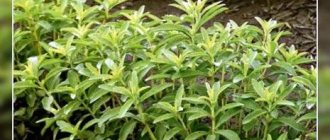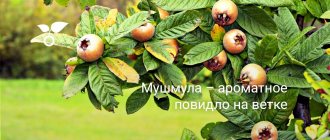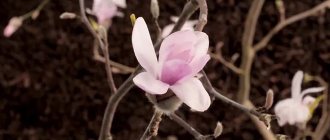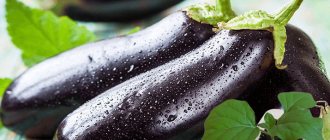Gooseberry crop beds
Black gooseberries surpass green ones in their useful properties, so gardeners increasingly began to give preference to varieties with dark berries. Thanks to modern breeding, many new black-fruited hybrids have appeared, but there are varieties that remain out of time and competition. This is the Black Negus gooseberry variety, bred back in the 20s of the last century by I.V. Michurin. For almost a hundred years, this variety has not lost its popularity, and to this day it is found more often than others in private gardens.
- 1 Feature
- 2 Planting bushes
- 3 Care rules
- 4 Advantages and disadvantages
- 5 Video "Rules for planting gooseberries"
Description and characteristics of gooseberry Black Negus
From America to the Eurasian continent was brought a fungal disease - spheroteca (lat. Sphaerotheca). It was also called American powdery mildew. Fruit bushes suffered most from it: currants, rose hips, gooseberries and others. Many discoveries have been made towards obtaining disease-resistant crops. For example, this is how the black gooseberry is obtained.
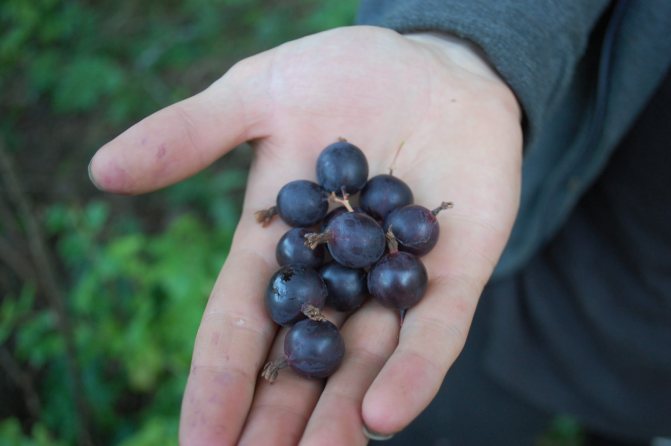
Black gooseberry berries
Origin story
IV Michurin in 1928 began work on breeding gooseberries, resistant to spheroteca. Success came after crossing the European large-fruited Anibut variety (Latin Ribes grossularia L.) with the North American wild gooseberry. The seeds of the ripe fruits were sown and in 1932 they gave the first harvest of large black berries with smooth skin. The hybrid was given the name Black Negus. It was used for subsequent breeding work, but the original was highly appreciated, and quickly spread in gardens throughout the USSR.
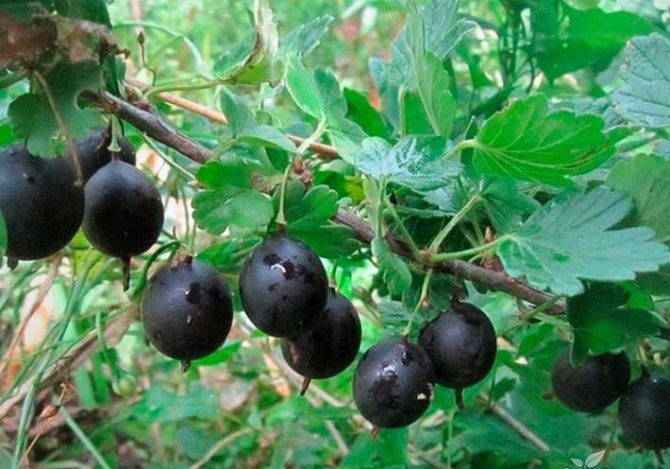

Black negus
Characteristics of the bushes
By the age of 4, the bush reaches a height of about 1.5 m. The shoots are strong, spreading, arched. The leaf is large, dark green, with slight pubescence. The spines are large and numerous, they are single, double, triple, with the tips bent down in the form of hooks.
Note! Increased prickling outwardly makes gooseberries related to blackberries and also allows the use of a shrub to obtain an impassable hedge.
Characteristics of berries
The black berries on the gooseberry are flat, inversely ovoid, about 2 cm across. The skin is dense and elastic, black with shine, without pubescence, sometimes with a bluish-gray waxy bloom. The average weight of the berry is about 3.6 g. Light green stalks about 18 mm long hold the berries firmly until ripening. The sweet and sour flesh is colored black and red with red carmine veins. Inside the berries are triangular brown-brown seeds. Ripening period - the second half of July.


Ripe berries on a branch
Healing properties of the plant


Black Negus gooseberries are high in vitamin C.
Black gooseberry has the following beneficial properties:
- Stopping the development of infectious pathologies.
- High concentration of vitamin C.
- Improving the normal performance of the nervous system.
- The presence of a huge amount of vitamins and minerals.
- Accompanying the healing of blood vessels.
- Relief of cardiac pathologies.
- Favorable effect on the skin.
- Beneficial effect on vision.
- The presence of folic acid in the composition.
- Normalization of the working capacity of the digestive tract.
- Rapid elimination of poisons from the body.
- The presence of anthocyanins in the composition.
- Treating anemia.
- Fiber saturation.


Fresh gooseberries are recommended for pregnant women.
The beneficial effect on vision is due to the presence of vitamin A.
Black gooseberry is of great benefit to the body of a pregnant woman. Due to the presence of folic acid in the fruit, the child develops harmoniously.
Thanks to anthocyanins, blood vessels are quickly cleared of harmful cholesterol. Blood pressure returns to normal, the risk of atherosclerotic plaques is reduced.
Black gooseberry fruits are recommended to be included in the menu of people suffering from diabetes.... They contain a minimum amount of carbohydrates.
The main contraindications
The black gooseberry has a number of contraindications.
- It is not recommended to eat it for people with a history of allergic reactions.... If you neglect this recommendation, the likelihood of developing Quincke's edema is high. Women who are lactating should also avoid eating berries.
- Against the background of a high acid content, the use of the fruits of this plant can provoke an exacerbation of gastrointestinal pathologies... For persons suffering from diseases of the stomach and intestines, gooseberries can only be eaten in the form of jam or jam.
- It is not recommended to mix gooseberries with dairy products... This combination has a powerful laxative effect.
Variety Black Prince
Gooseberry Grushenka - features and characteristics
The newest seedlings on sale may be called the Black Prince. They may differ from their predecessor in the size of the berries, the number of thorns, the shape and color of the leaves. But in general, the yield and characteristics of the berries remained the same and serve as a kind of benchmark for comparison with gooseberries of other colors.
Note! The dark gooseberry has been cultivated for almost a hundred years. Resistance to a dangerous fungal disease is far from the only advantage of the fruit crop.
Ripening period and yield
The exact ripening dates for berries depend on the growing region and weather conditions. But usually the crop is harvested in the second half of July after the 20th. The bush gives the first berries already in the 2nd year of life, and by the 4th year it shows its full potential - about 7 kg per season. Ripe berries sit firmly on the branches and do not crumble even after rain.
Taste qualities
Gooseberry Consul - features and characteristics of growing
Although the skin is rather thin, the berries tolerate transportation well, do not wrinkle or burst. The taste is considered dessert - sweet with a pronounced pleasant sourness, deserves a score of 4.7 points on a 5-point scale.
Note! According to gardeners, the taste and texture of the berries are very reminiscent of Isabella grapes.
Drought resistance and frost resistance
The variety is frost-resistant. Without shelter, it can winter in regions with a winter temperature minimum of -25 degrees. The culture can be classified as drought-resistant. Moreover, when planted near water bodies or in damp lowlands, the bushes suffer from root rot.
Disease and pest resistance
In addition to the spheroteca, the culture is immune to rust and common powdery mildew. It is extremely rarely affected by infectious diseases. The variety is not resistant from the pests common in the middle lane - aphids, moths, gall midges and others.
Using berries
Black gooseberries are versatile. Berries can be eaten fresh, juiced, dried and frozen for long-term storage. There are many recipes for jam, jams and compotes with black chokeberry, and they also make dessert berry wine, liqueurs and liqueurs from it.
Testimonials
Gooseberry flavor Black Negus is my favorite.The berries are sweet with an interesting wine aroma, stay on the stems for a long time in a fully ripe state, do not crumble. My bush grows in partial shade, while sugar is not lost in taste.
Before planting gooseberries, be sure to carefully remove the roots of weeds from the site. The first time I planted gooseberries and did not remove the leek roots, as a result, the weed began to grow in the root zone of the gooseberries, and it is very difficult to weed under the stems, the branches are prickly and hurt my hands.
Judging by the reviews, black gooseberries are the most useful, so I consider Black Negus as a natural dietary supplement.
There is nothing complicated in the cultivation of the Black Negus gooseberry. Even an inexperienced gardener can easily cope with the task, since minimal care is required. 7 kg of selected berries from a bush (almost a bucket) is the best payment for taking care of a thorny bush.
Advantages and disadvantages of the variety
Among the positive qualities of the Black Negus:
- Pleasant taste of large and juicy berries.
- Universal purpose.
- High yield from the 2nd year after planting (up to 7 kg per bush).
- Berries keep up to 4 weeks.
- Good transportability.
- Frost resistance up to -25 degrees.
Gooseberry Commander - features and characteristics
The disadvantage is the large number of thorns on the branches, because of which it is best to pick berries with durable gloves.
Note! The shrub takes root well along the fences, turning them into an insurmountable obstacle for animals and people.
Orange-gooseberry compote
Joshta and orange in compote create a wonderful, unique duet. The citrus fruit gives a special aroma and a sour-bitter taste, which is sometimes lacking in a tasty and sweet berry.
A three-liter jar of compote will require a glass of black ripe gooseberries, one orange, three hundred grams of sugar and three liters of water. The fruit does not need to be peeled; it will be required along with the peel. It is enough just to cut it into circles. Put berries and orange slices in a jar. Meanwhile, put the water to a boil. Then add sugar and prepare syrup, stirring occasionally. After boiling again, pour it into a jar and roll up the lid. Leave to cool upside down.
Planting young seedlings on the site
Varietal planting material is bought in nurseries, giving preference to seedlings with a closed root system. A distinctive feature is sharp thorns.
If the seedling is purchased in a container with soil, then no preparation is required for it. Instances with bare roots are soaked in water for a day, adding a fungicide or a growth stimulant to it. In the spring, the bushes should be with dormant buds, and in the fall - without traces of diseases on the branches.
Planting in spring is carried out in the first half of March, when the snow has just melted in the beds. Autumn planting is performed after shedding foliage. 1-1.5 m are left between the bushes, and with an ordinary planting - up to 1.5 m between the rows.
The place for the Black Negus should be very sunny, without any shading, but always protected from strong winds. It is best to plant on a small hill or on a slope so that no stagnant water forms at the roots.
Site preparation
The earth is dug up 10 days before planting, adding compost or humus to it. If the soil is prepared in the fall, then a little sand is introduced into it mixed with rotted sawdust to improve its structure. The optimum acidity level is pH = 6.0. Trenches and planting holes are dug from north to south.
The work is performed in the following order:
- Dig planting holes 50x50 cm.
- The backfill soil is mixed with 50 g of superphosphate and 50 g of potassium fertilizer.
- Garter pegs are installed at the bottom of the holes.
- The root collar is buried 5-10 cm.
- After backfilling, all the bushes are watered - 10 liters of water for each.
- Trunk circles are mulched with peat or sawdust.


The appearance of a freshly planted bush in spring
Bush formation
The gardener should not forget about the formation of a bush. This process is very important and requires special attention. The gooseberry bush grows rapidly, all its branches are strewn with thorns. If you abandon it and do not carry out pruning, then harvesting will become difficult and unpleasant. It is advisable to prune in the fall. During pruning, all old, dried and damaged branches are removed. After pruning, only a few of the strongest shoots should remain, on which there are branches. The length of these shoots after pruning should be on average 50 cm. In order not to damage the hands with thorns during work, you need to take special long-handled scissors.
Features of seasonal care
They begin to care for gooseberries in early spring and end only in late autumn. Agricultural rules are standard for this fruit crop.
Watering and feeding
The black negus does not like prolonged drought and also negatively perceives prolonged rains. If it rains every week in the summer, no watering is required. In a dry summer, water is watered every week - 10 liters of water for each bush.
If, during planting, compost or humus was introduced into the ground, then the first top dressing will need to be applied only in the 3rd year.
Note! It is best to use monthly watering for gooseberries with mullein solution or with the same frequency with complex mineral fertilizer.
Mulching and loosening
With the help of mulching near-trunk circles, several problems are solved at once: you do not need to water gooseberries too often, and weeds practically stop growing on such soil. Since the root system lies close to the surface, when mulching, you will not need to loosen the soil after watering, it will not dry out with a crust and crack in dry times.
Using supports
Supports are used for trellis plantings. They are installed at the ends of the rows and a wire is pulled between them at a height of 50, 80 and 100 cm from the soil level. Gooseberry whips are tied to them as they grow in bundles of 5 pieces.
Under unfavorable conditions, gooseberries can suffer from diseases and pests, so they must be sprayed before flowering, as well as after harvesting.
In the spring, the shoots are shortened by a third, removing broken, diseased, dry and old branches. The branches growing horizontally are not useful either. The optimal number of shoots is no more than 20 for a bush over 4-5 years old.


Gooseberry pruning scheme by year
Shelter for the winter is required only in regions where frosts drop below -25 degrees. For protection, the bushes are spud up with peat or sawdust, and then covered with spruce branches, agricultural cloth, burlap.
conclusions
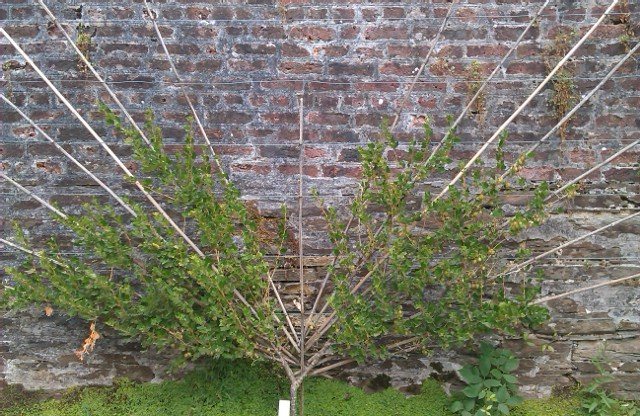

Trellis gooseberries are easier to care for and easier to harvest.
A serious drawback of black gooseberries is the presence of a large number of sharp thorns. Against this background, harvesting can be significantly difficult.
According to experienced gardeners, the crop can be planted on a trellis. This method can ensure safe harvesting of the fruit. The pruning procedure will also be fairly straightforward.
Reproduction
Negus is a gooseberry that easily multiplies in a variety of ways, up to sowing seeds. Choose the method that is most convenient under the given conditions.
By cuttings
Last year's shoots 12-15 cm long with 3-4 buds are excellent planting material. They are cut before flowering and immediately planted in the ground, covered with plastic bottles on top. Successfully rooted specimens are planted after a year to a permanent place.
note! You can germinate twigs in a container with water.
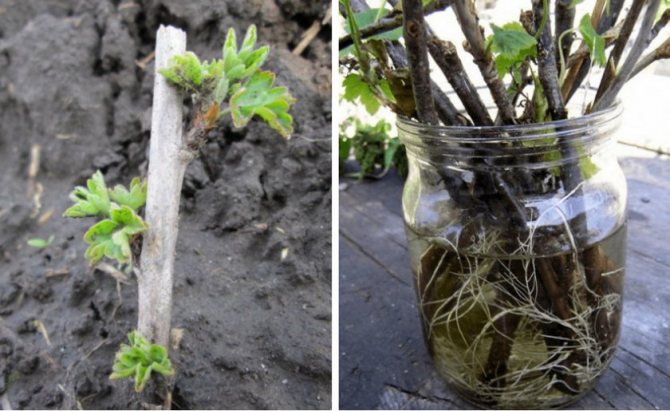

Rooting gooseberry cuttings in soil or water
By dividing the bush
Bushes over 4 years old can be dug up and divided into 2-3 parts, each planting in a separate planting hole. The best time for this is mid-March before the start of sap flow.
Layers
The shoots are bent to the ground and buried in early spring. With successful rooting, young bushes are planted in a permanent place only a year later - in May.
Shoots
Roots are usually cut to avoid thickening of the bush. But if necessary, it is carefully dug out, cut off from the main roots and planted in a new place. The best time for this is May or the end of August.
Note! If you spill the bush high in the spring and water it abundantly all summer, then by autumn many new branches will form, which are carefully separated and planted in a new place.
Imperial Yoshta Jam
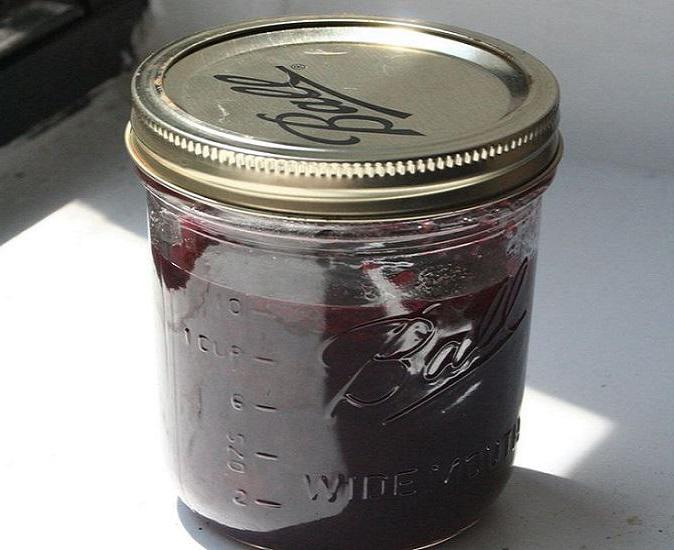

To make black gooseberry jam, you will need a kilogram of this berry, a kilogram of granulated sugar (if possible, it is better to replace it with honey), half a liter of water. If desired, you can add a few leaves of black currant, cherries, a sprig of mint or lemon balm.
Pour water into a saucepan, add sugar and cook until it is completely dissolved. At the stage when the syrup thickens, you can put leaves of berries or branches of fragrant plants in it for flavoring. The taste will be much more interesting with them. Pour gooseberries into hot syrup, cover the pan with a lid and turn off the stove. Leave the berries in this way for two to three hours. After that, you need to remove all unnecessary (leaves and twigs). Put the pan on the fire again and bring to a boil. After six minutes, the jam can be removed from the stove - it is ready. It remains only to put it in jars and roll up the lids.

